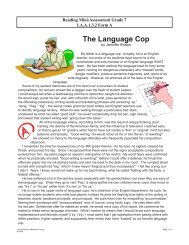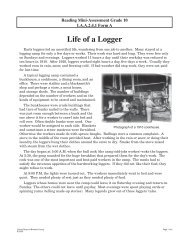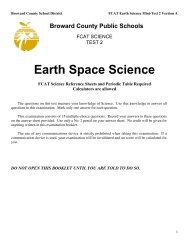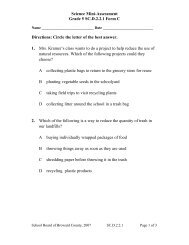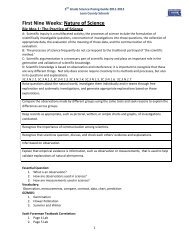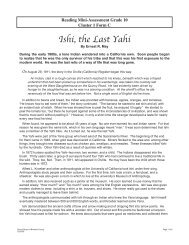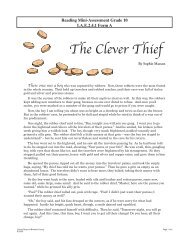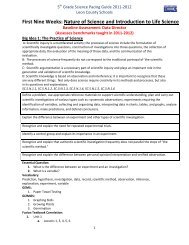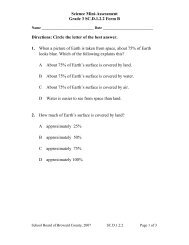Reading Mini-Assessment Grade 8 Cluster 1 Form B
Reading Mini-Assessment Grade 8 Cluster 1 Form B
Reading Mini-Assessment Grade 8 Cluster 1 Form B
You also want an ePaper? Increase the reach of your titles
YUMPU automatically turns print PDFs into web optimized ePapers that Google loves.
He wove willows into a large, open basket,<br />
then stretched buffalo hides over this frame and<br />
lashed them to the rim. When he was finished,<br />
he drifted down the river in his bullboat.<br />
When he reached the marshes near Great Salt<br />
Lake, he noticed that the boat floated higher in<br />
the water. Scooping up a handful to drink, he<br />
discovered the water was salty and quickly spat<br />
it out. Upon returning to camp, he reported<br />
that he had reached the<br />
Pacific, but on a later trip,<br />
he skirted the shoreline and<br />
realized his mistake.<br />
In 1847 pioneers arrived<br />
in Salt Lake Valley to build<br />
a permanent settlement.<br />
They noticed mounds of<br />
sparkling salt dotting the<br />
shore of the lake. Within<br />
days they built kettles to<br />
boil water and harvest pure salt to trade and<br />
use for preserving food. Everyone enjoyed<br />
swimming in the briny water—even nonswimmers<br />
remained afloat. The settlers named<br />
their new community Great Salt Lake City<br />
after their impressive neighbor. However, the<br />
pleasant lake soon became a creeping monster.<br />
The lakebed is shallow, and the land around it<br />
is extremely flat. If the water rises only a few<br />
inches, it quickly spreads over many feet of<br />
shoreline. By 1867, Great Salt Lake had risen<br />
twelve feet and extended its surface about 900<br />
square miles! Fortunately, the water receded<br />
before the growing city became a swamp.<br />
The lake has had many ups and downs since<br />
then. At times people thought it might dry up<br />
completely, but in the mid 1980s, the water<br />
rose so much that it flooded the highway along<br />
the southwest shore and ruined hundreds of<br />
acres of rich farmland. Great Salt Lake is still<br />
the largest body of water west of the Mississippi<br />
River; it is approximately 75 miles long and 50<br />
<strong>Reading</strong> <strong>Mini</strong>-<strong>Assessment</strong> <strong>Grade</strong> 8<br />
<strong>Cluster</strong> 1 <strong>Form</strong> B<br />
bullboat<br />
miles wide.<br />
Why is the lake so salty? Rocks contain<br />
small quantities of salt that dissolve easily in the<br />
water. Rain or melting snow releases this salt<br />
and carries it into streams. Great Salt Lake is fed<br />
by three rivers, as well as several small streams<br />
and springs. In most lakes, salt is carried out as<br />
fast as it is brought in, keeping the water fresh,<br />
but Great Salt Lake has no outlet. Evaporation<br />
takes water out of the lake,<br />
but the salt stays.<br />
In dry years more<br />
water evaporates, and the<br />
lake shrinks and becomes<br />
saltier. During wet cycles,<br />
the lake grows and the<br />
water is less salty. Over<br />
the last century, Great<br />
Salt Lake has averaged 25<br />
percent salt. Ocean water<br />
is only 3 percent salt. Because the water is so<br />
salty, companies harvesting at Great Salt Lake<br />
can make salt faster and cheaper than those<br />
using ocean water. Great Salt Lake is not a<br />
beautiful, picture-postcard mountain lake. At<br />
first glance the landscape seems empty and<br />
barren. There are no trees on the shore, and to<br />
the west stretches an immense salt desert. The<br />
water itself is another kind of desert. Nothing<br />
but algae and brine shrimp can survive such a<br />
salty bath.<br />
But despite its barren appearance, the<br />
lake is far from dead. Its islands and marshes<br />
provide an important rest stop for migratory<br />
birds. The mouth of the Bear River, where Jim<br />
Bridger drifted into the lake, is a protected<br />
bird refuge. Over 200 different species have<br />
been identified there as they travel between<br />
North and South America. Millions of brine<br />
flies living by the shore provide plenty of food.<br />
Some birds–California sea gulls, ducks, geese,<br />
and pelicans—return every summer to build<br />
School Board of Broward County Page 2 of 7<br />
11/20/06





